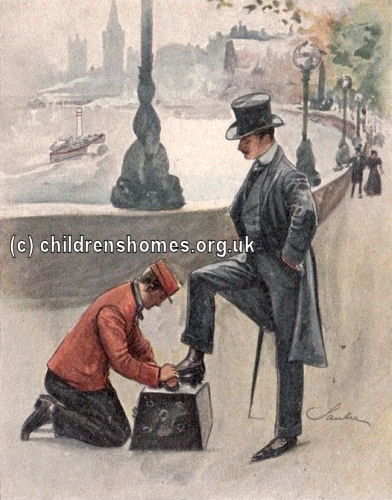Notting Hill Shoeblack Society, Notting Hill, London
The Notting Hill Shoeblack Society was established in 1869, one of a dozen or so Shoeblack Brigades established in London in the mid-19th century to provide employment and accommodation for homeless and destitute boys. The Society had premises at Shaftesbury Hall, Prince's Road, Notting Hill, where up to 75 boys aged from 14 to 19 could be housed. Boys were usually selected for admittance to the Brigade after the Sunday evening service in the school room at St James's Place, Notting Hill, with preference given to those attending the Ragged Schools. A club, with various amusements, was run at the home on five nights in the week after school until 10 p.m.

A London Shoeblack, c.1880s. © Peter Higginbotham
Shoeblacks were allocated pitches or 'stations' by the police and these were rotated twice a week so everyone had a turn at working at the most lucrative locations. Each Brigade had a distinctive uniform, with the Notting Hill boys' outfit being a blue tunic. The boys' earnings were paid into the home each day with a third of the money paying for their keep, a third being placed into their individual bank savings accounts, and a third given back to them. The boys' uniform, brushes etc. were supplied by the Society and paid for out of their wages.
The Notting Hill Brigade appears to have ceased operation by the 1890s.
Records
Note: many repositories impose a closure period of up to 100 years for records identifying individuals. Before travelling a long distance, always check that the records you want to consult will be available.
- None identfied at present — any information welcome.
Bibliography
- Higginbotham, Peter Children's Homes: A History of Institutional Care for Britain s Young (2017, Pen & Sword)
Links
- None identified at present.
Except where indicated, this page () © Peter Higginbotham. Contents may not be reproduced without permission.


